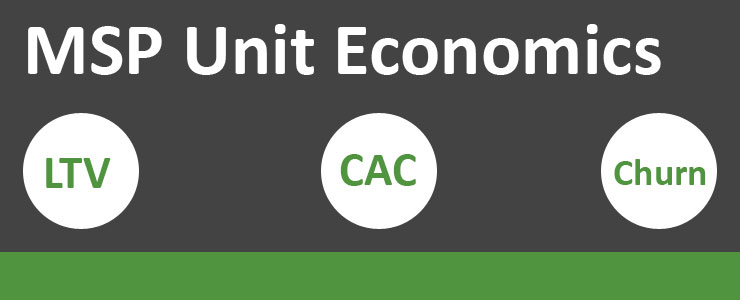
When I started my MSP in 2000, I really wish someone had told me about Unit Economics and how important these metrics are in understanding how to scale a recurring revenue business.
I probably shouldn’t feel to bad , because it wasn’t until the world of Software-as-a-Service (SaaS) came about with the godfather of SaaS, SalesForce, before people started paying attention to these metrics or even defining these metrics.
So what are unit economics?
Think of unit economics as the key business metrics SaaS companies use to understand growth, sustainability and how much to invest in growth.
One of the thoughts leaders in this space, David Skok, defines it in this post with an excerpt below (here):
A great way to understand any business model is to answer the following simple question: Can I make more profit from my customers than it costs me to acquire them? This is effectively a study of the unit economics of each customer. To answer the question, we need two metrics:
The final metric which we’ll address today is:
So how does that relate to my MSP?
Good question, well think about the business model of most MSPs. It’s all about recurring revenue or in SaaS speak, Monthly Recurring Revenue (MRR) or Annual Recurring Revenue (ARR). That is the same business model as SaaS companies, aside from the professional services and product resell.
I believe these metrics are crucial to understand.
LTV (Life Time Value)
When you sign up a new monthly support deal, what is the Life Time Value? Do you know how long your customers stay on board? If it’s 24 months and you sign up a deal worth $1K per month, then on average that deal is actually worth $24,000.
The higher the LTV the better.
At my MSP we had an average of 4 years. So it means any client you sign up is going to deliver on-going revenue for quite some time. That’s great.
The key point if you have a low LTV is you need to focus on making the customer happier with your products and services OR find more aligned customers that value your services. That will drive up your LTV.
CAC (Customer Acquisition Cost)
So this leads me to CAC.
If you know your LTV, you can start to determine how much you can afford to pay to get a new client with your marketing – your Customer Acquisition Cost (CAC).
The key point is, if I said to you, give me $4800 for every new client you get, you might think that’s expensive. But if your LTV is 24 months, ($24,000), then $4800 seems quite reasonable. Food for thought.
Customer Churn
The final metric is customer churn. So you know your LTV and CAC, but the metric that destroys LTV is Churn. You must do everything in your power to reduce customer churn.
There is no point being awesome at signing up new clients on monthly support deals when you’re service offering is not performing optimally.
The key tip here is to aim for a less than 1% per month churn (12% per year) or of course as low as you can get it.
Dollar Churn VS Badge Churn
You also must understand the difference between ‘dollar churn’ and ‘badge churn’. Dollar churn is the amount of money you lost versus badge churn which how many clients you lost. You want to focus on dollar churn. For example, if you sign up every year $40,000 per year in Monthly Support (after 12 months of selling) but you lose $30,000 in Monthly Support over the same period, you’re not growing very fast. If you’re goal is to hit a certain revenue figure you need to absolutely control your churn.
Tips to reduce Churn and increase LTV
From my experience to reduce client churn and increase life time value, your MSP should be doing the following:
More Information
If you’d like to read more about unit economics and other SaaS learnings which relate to your MSP I recommend going to the following websites:
I hope this article helped and wish you continued MSP success.